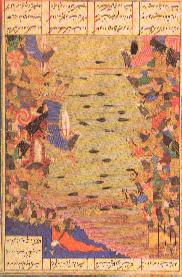
The Naimisha Journal
Islam has a long history of using terror as a political instrument. The most famous of these was the ‘Fort of the Assassins’ of the founder of the Ismaili order. It was finally destroyed by the Mongols under Haleku Khan.
Some leaders and
writers, including the U.S. President George Bush, have called the present
campaign against Islamic terror a ‘crusade’. The comparison is not apt. The
Crusades were a series of campaigns by the Christians of Europe to recover
Jerusalem from the Muslims. They ended in failure. They were sometimes brutal
but there was no use of terror against innocent men and women as we see in the
acts of terrorists today. The Crusades were set battles of soldiers against
soldiers, in which both sides for the most part observed the rules of chivalry.
At the same time, terrorism, by which we mean the threat and use of violence against innocents, has a long tradition in Islam going back to Prophet Muhammad himself. The Hadits (record of the acts of the Prophet) record that the Prophet had the poetess Asma bint Marawan assassinated while sleeping with her child. Her crime was satirizing the Prophet and his claims in some of her verses.

The most famous of the Islamic terrorist organizations was the Nizari Ismailiyun, a Shiite politico-religious sect, founded in 1094 by Hasan-e Sabah. He and his followers captured the hill fortress of Almaut in northern Iran, which became their base of operations. Hasan styled himself Grand Master and went on to set up a network of terrorist strongholds in Iran and Iraq. He had trained assassins, most of who according to Marco Polo were drug addicts. According to Marco Polo, young boys captured by the Grand Master were turned into addicts by giving them progressively large doses of the drug hashish. This way they were totally dependent on him and would do anything in return for hashish. They came to be known as hashishin, from which get the word ‘assassin.’ So the use of narcotics in terrorism is nothing new.
Some historians doubt
Polo’s account, but it is difficult to believe that he made up the whole
thing. What is not in doubt, however, is the fact that Hasan-e Sabah and his
successor Grand Masters commanded an army of assassins who spread terror among
the people in Iran and Iraq. According to the Encyclopaedia
Britannica, The
Grand Master had “a
corps of devoted terrorists, and an unknown number of agents in enemy camps and
cities, who claimed many victims among the generals and statesmen of the Abbasid
caliphate as well as several caliphs.”
The Nizari Ismaliyun or the Order of the Assassins expanded into Syria
after its founder’s death. In the 12th century, Rashid ad-Din as-Sinan,
famous as the ‘Old Man of the Mountain,’ set himself up as an independent
Grand Master of the Assassin Order in the impregnable castle of Masyaf in Syria.
For over a century and a half, from 1094 to 1256, these Grandmasters and their
assassins spread terror throughout the Middle East. Their end came at the hands
of the Mongol warriors of Haleku Khan—the grandson of Chengis Khan. He
captured and destroyed assassin strongholds in Iran one by one, and finally
Almaut itself in 1256. Two years later, in February 1258, Haleku’s soldiers
sacked Baghdad itself and ended the Caliphate by executing the Abbasid Caliph
al-Mustasim and his sons.
The Syrian castles and strongholds were gradually reduced by the Baybars
I, the Mamluk Sultan of Egypt. The Ismaili order gradually faded into
insignificance, becoming a minor heresy. It still has some followers in Syria,
Iran with India and Pakistan having the largest numbers. They are known as
Khojas and are followers of the Aga Khan. In Pakistan though they are considered
non-Muslims and sometimes persecuted.
In more recent times, terror was used to gain political ends by Mohammed
Ali Jinnah. In 1946, his call for ‘Direct Action’ in support of his demand
for Pakistan led to street riots all across North India. The Congress party,
which had won the election by promising that it would not allow India to be
divided, capitulated and agreed to the Partition of India.
In all this, there is an almost religious belief that terrorism pays. In
the Pakistani official manual The
Quranic Concept of War by
Brigadier Malik, it is explicitly stated: "Terror struck into the hearts of
the enemy is not only a means, it is the end in itself. Once a condition of
terror into the opponent's heart is obtained, hardly anything is left to be
achieved... Terror is not a means of imposing decision upon the enemy; it is
the decision we wish to impose upon him.”
The authority for this is the Koran
(Anfal 59-60): “Against them make ready your strength to
the utmost of your power, including steeds of war, to strike terror into the enemies of Allah and your enemies,
and others besides, whom ye may not know, but whom Allah doth know.”
This is the seed of indiscriminate terror employed by Grand Masters of the Order of the Assassins centuries ago, and by Osama Bin Laden and a host of others today. This belief in the power of domination through terror — and its legitimacy — is what needs to be defeated. Liberal thinkers in the Islamic world must seriously consider the consequences of continued acceptance of such doctrines. All other religions have reformed, removing and softening anti-human elements contained in their scriptures. Muslim leaders cannot keep insisting that everything in their scripture must be accepted without question not only by believers but also non-believers.